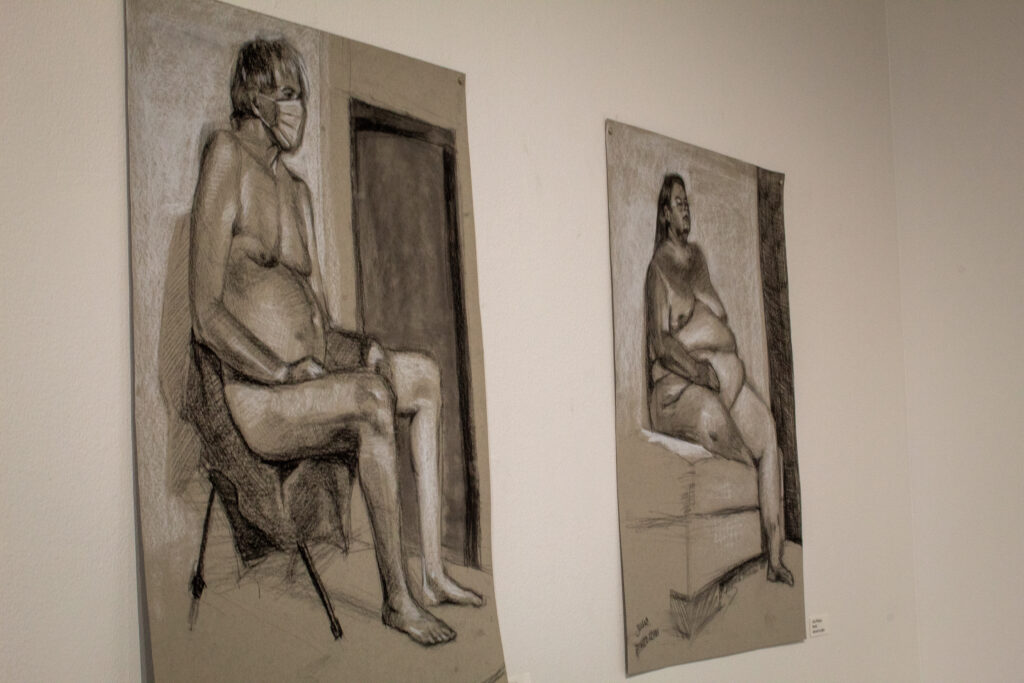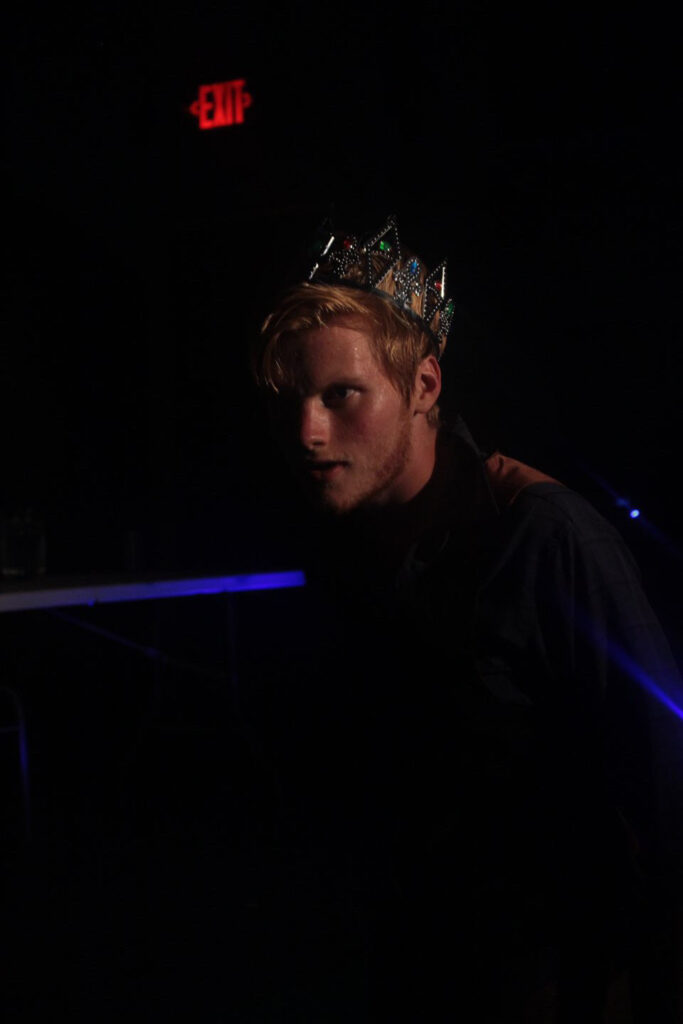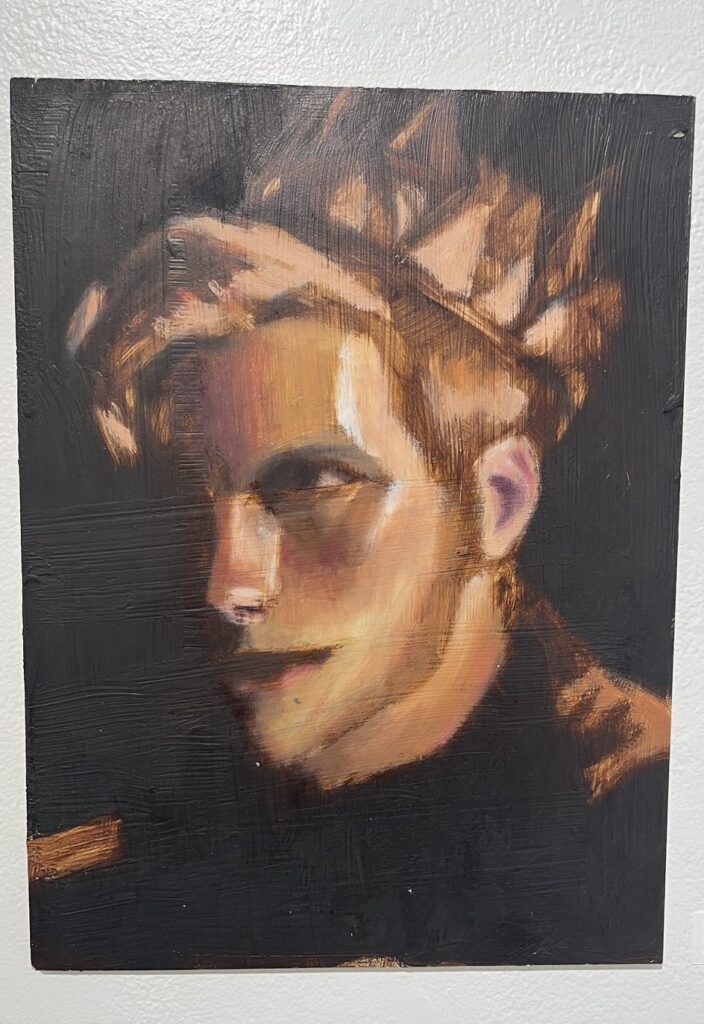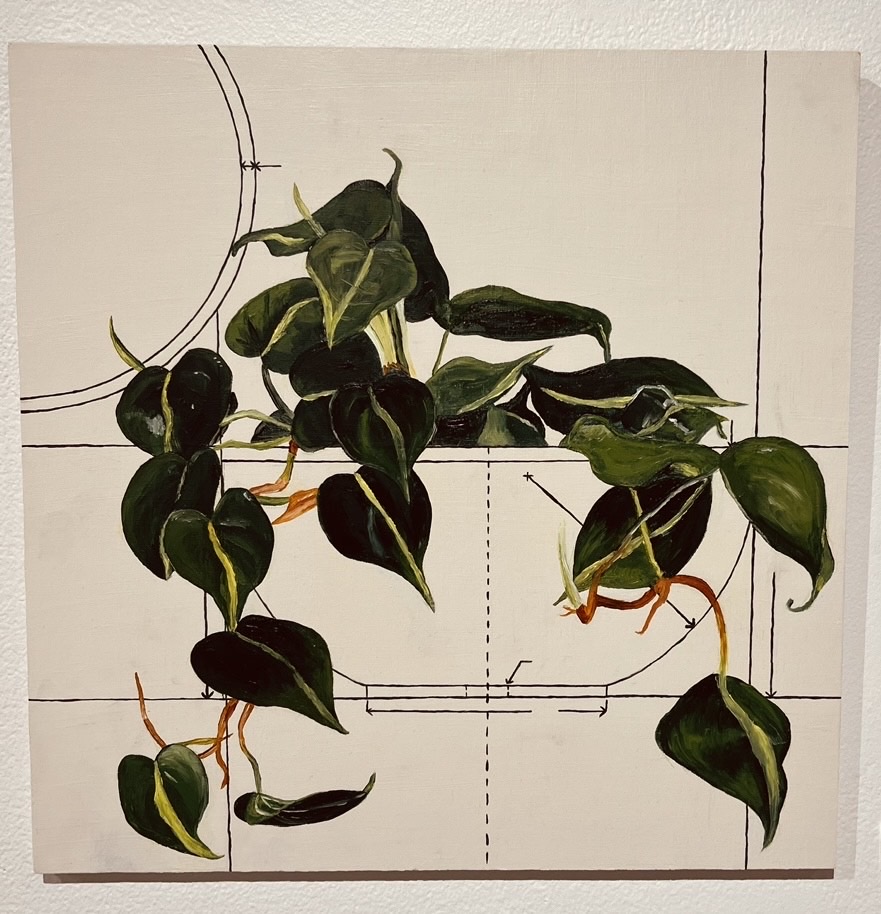WILL KARR
Editor in Chief

Fredonia art students are stepping outside of their digital art majors for the “Analog” exhibition at the Emmitt Christian Gallery. The “Analog” exhibit, located in Rockefeller Arts Center, room 217, displays student artists’ exploration of several mediums.
“Analog” features work from 12 student artists, who created their pieces for Professor Nick Borelli’s Life Drawing and Painting and Drawing I and II courses. The exhibit, which was curated by Borelli, features a wide range of work including portraits, paintings and drawings. The exhibit will be on display through March 2.
In a world influenced by digitalization, the exhibit strives to focus on non-digital art pieces created by the students.
“‘Analog’ is an antonym to digital — the students spend a lot of time, not just creating the art but throughout their day, in the virtual world, while I want them to engage with physical reality when they are drawing and painting,” Borelli said. “‘Analog’ can also mean something that is similar to something else … painting and drawings can be thought of as analogous to our own reality.”
Ben Evans, a sophomore animation and illustration major, whose oil painted self-portrait on a panel is being featured in the exhibition, discusses the duality of art. The portrait was created for an assignment in Borelli’s Drawing and Painting class. Art can not only make sense of current realities, but it can also create new realities, worlds and alternate universes.
“I always thought that I would get annoyed with the side of art that is trying to create things that already exist because I want to think of things that don’t already exist,” Evans said. “But, you have to learn how to draw real things first and there is so much joy that comes from drawing real things.”
Evans said that both his digital and analogous works have been heavily influenced by his physical surroundings and outdoor experiences. Growing up, nature provided him with a sense of escape from his reality, providing an outlet for his imagination to flourish.
“[As a child], I would go into the woods and pretend that it went on forever. … I would just walk out there for hours and dream up little fantasy worlds and stories,” Evans said. “… As I got older, I realized how artists and writers could shape their stories, and they could take their imaginations and share them with other people.”
Evans’ self-titled self portrait was inspired by his experiences as an instructor at a summer camp, where campers practiced theater reenactments. Evans was playing King Duncan in a scene from Macbeth wearing a crown when a student took the photo of him that inspired the self-portrait.

at summer camp.
“That Drawing and Painting self-portrait was a completely different experience than drawing one for Life Drawing, where I was in control of the camera,” Evans said. “With the [one in the exhibit], I was putting on an act and inhabiting a character, but I didn’t see myself until I saw that picture. I can recognize parts of myself in that portrait, but the subject is also a stranger because I am pretending to be someone else.”
The portrait juxtaposes realism with fantasy, challenging the idea of what ultimately constitutes a self-portrait. Evans said that he enjoys how the portrait evokes images of royal portraitures, which have been created throughout history to express discontent with royal rulers.
“I like that I can make a half-satirical portrait, while acknowledging the other side of wanting to see myself look powerful and strong, whether it’s a part of my actual presence or not,” Evans said.
Evans explained how he believes drawing a self-portrait is different from drawing a portrait of someone else.
“In some ways, a self-portrait is scary because I am putting a representation of myself up there for everybody to see. In other ways, I think it’s a lot more freeing than doing a portrait of someone else,” Evans said. “It’s also a weird experience of examining yourself in a different way than you normally do … you have to go beyond what you think your face looks like and who you think you are presenting to the world.”

Julia Whitney, a senior graphic design major, whose charcoal portraits titled “Rachael” and “Steve” are being featured in the exhibit, expressed similar sentiments. Whitney enjoys drawing and painting, but said that she ultimately chose to major in graphic design because she thinks it will be easier to find a career in. Whitney said that her pieces in the exhibit are different from the graphic design based work that she usually creates.
Whitney has loved painting ever since she was little. In the third grade, she dressed up as an artist for her school’s career day. Whitney explained how going into a self-portrait, an individual already has preconceived notions of how they look as opposed to drawing a portrait of someone else who is a complete stranger.
“I find it alot easier to do other people than yourself because when you have been looking at yourself in the mirror for so many years, you have this idea of what you look like in your head,” Whitney said. “Self-portraits are much harder because when you are looking at someone else you can be more objective about it.”
Whitney’s portraits of Rachael and Steve were created for Borelli’s Fall 2022 Life Drawing class. The two live nude models would come into the classroom for hours at a time on alternate days.
“I don’t remember how I reacted the first time, but it is definitely something that you have to get used to. I think at first you maybe don’t know what you are getting yourself into. All of a sudden, someone walks on stage with a robe and then they get completely naked,” Whitney said. “But it’s nice to have the same two models through the course because you learn much more about each person’s body, the ins and outs.”
There are many different career paths that an artist can take. After graduating from Fredonia this spring, Whitney hopes to become an art teacher. Jimmy Keller, a junior sculpture major whose work is also being featured in the exhibit, wants to be an art professor.
“[After Fredonia], I want to continue doing what I want to do. As artists, we have to sort of make our own path,” Keller said. “But, making your own path is a plus because it means you have options.”
In his wood panel oil painting “Decomposing,” Keller references the intersectionality between humanity and nature. Keller paints plants on top of an architectural and manufactured surface.

“[Through the piece], I wanted to show the difference between the live, growing and thriving plant with the more human form of the pot — juxtaposing the inorganic with the organic,” Keller said.
Keller said that he specifically chose the name “Decomposing,” to reference not the plants in his piece breaking down, but instead how the pot is being reduced to its “simplest form”: a blueprint.
Growing up, Keller said that he was always outdoors. At the age of 15, he started making wood chainsaw carvings.
“That is when I began professionally making a living as an artist and selling my pieces doing costume work,” Keller said. “Since then, I entered into sculpture and then have expanded upon that. A lot of my pieces now are inspired by nature.”
Similarly to Keller, Patch Parsons, a senior animation and illustration major, also has a wood panel oil painting in the exhibit. Their “Still Life” oil painting is different from the animated, digital and comic based work they tend to create.
“The painting in the exhibit was the quickest painting from that ‘Still Life’ series we were doing that I did,” Parsons said. “[Borelli] really liked it because he thought that working quickly made it more impressionistic.”
Overall, the exhibition brings together a wide range of student work.
“I think that the common thread in the exhibition is just these students showing both an understanding of the technical aspects of drawing and painting, and using their skills to do something unexpected,” Borelli said. “Everything in the show displays a really impressive technical ability, or is an image I haven’t seen anything like before, or both.”
